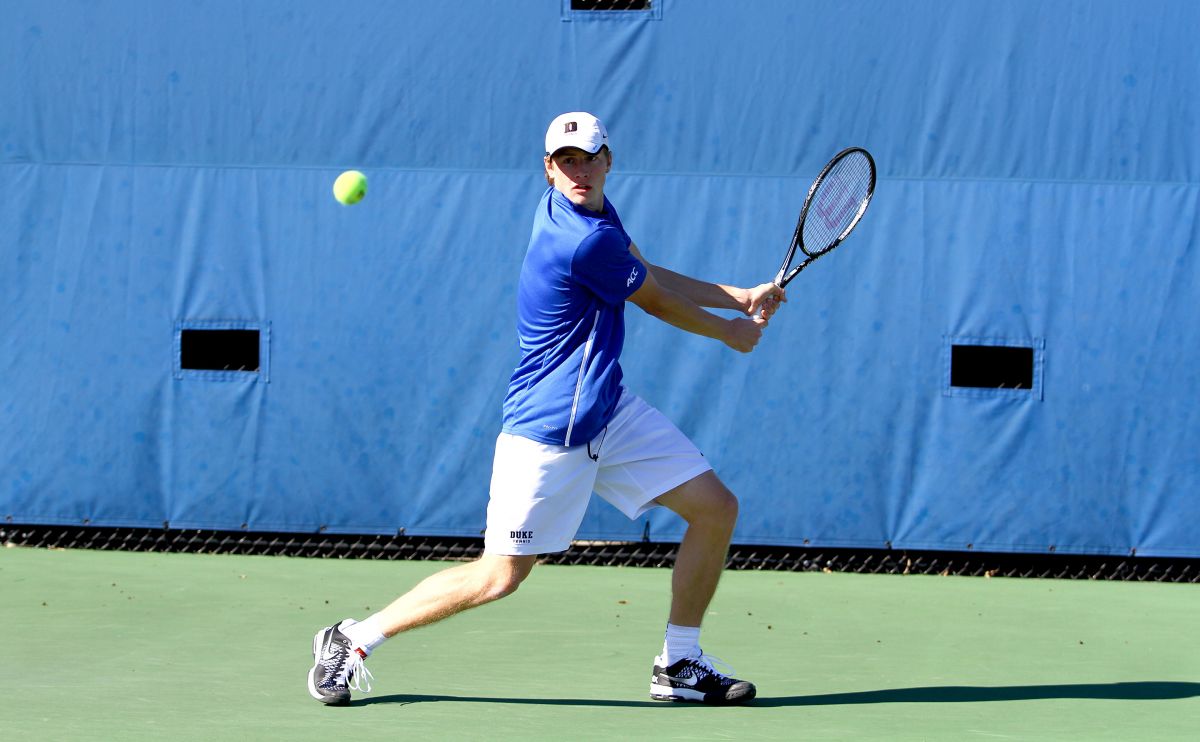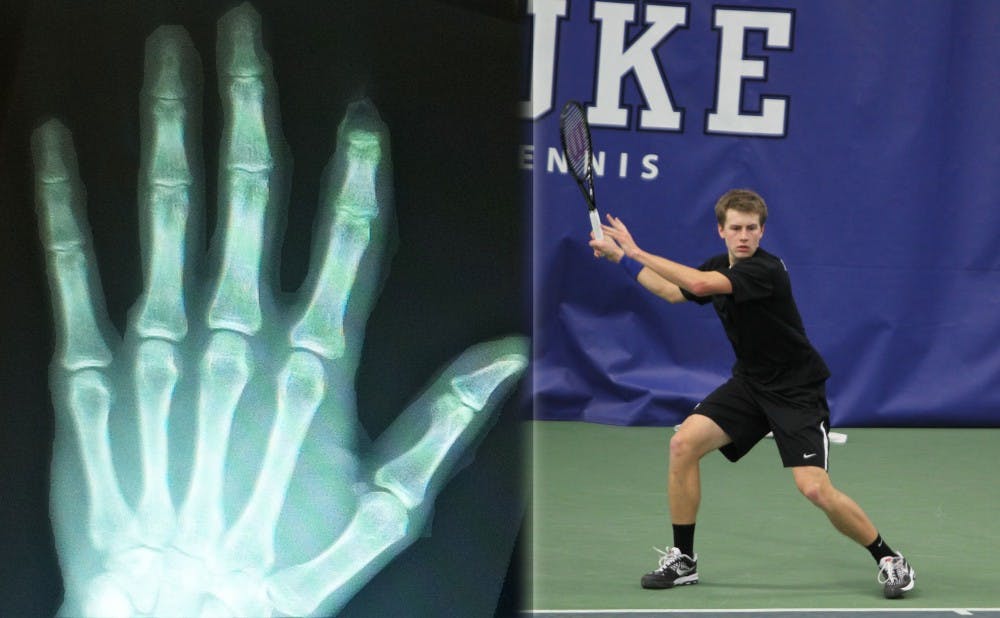Did your mother ever tell you to not climb fences?
Unfortunately for Duke redshirt junior Cale Hammond, that was one piece of advice he had to learn the hard way.
Hammond was playing what seemed to be a routine point in a March 13 match against San Diego State when he made a play that would lead to one of the most bizarre and serious injuries to ever happen during a tennis match.
With his doubles match tied at 1-1, Hammond’s opponent hit an overhead that looked like it was going to go over the back fence. Hammond, refusing to give up on the play, ran back and tried to climb the fence to make a play on the ball.
That’s where things went horribly wrong.
“I jumped up to get it and I put my hand on the gate to brace myself,” Hammond said. “When my body hit the fence, it swung open and my finger was in the wrong place and it got smashed off.”
When he hit the ground, Hammond had lost the tip of his left index finger. Playing tennis.
“As soon as it happened I knew I broke my finger but that’s all I knew immediately,” Hammond said. “Then I looked at it when I landed and I saw the bone and the fingertip was gone and then blood started flowing so I called for a doctor.”
Hammond was rushed to the emergency room by his parents, along with the remaining portion of his finger on ice. Upon examination, the doctors realized that there would be no way to reattach the finger without nerve damage, so they opted to amputate, cutting down the bone so that skin could be wrapped over.
Amazingly, Hammond isn’t the first athlete to ever lose part of a finger in a fence-related injury.
Professional Swiss soccer player Paulo Diogo suffered a similar injury in 2004. After setting up a goal for Servette F.C. teammate Jean Beausejor, Diogo jumped up on a fence separating the fans from the pitch to celebrate. The newlywed did not notice that his wedding ring got caught in a barrier, and as he jumped down, part of his finger tore off with the ring.
What separates Hammond’s injury from Diogo’s is that Hammond’s didn’t come from a foolish celebration, but rather from giving maximum effort to try to keep the point alive.
“If I cut my finger off doing something stupid or dangerous it would be a lot more depressing,” Hammond said. “The fact that I did it going for a ball, doing what I love—playing tennis—makes it feel like it was supposed to happen.”

It is this heart and hustle that Duke will miss in his absence, as Hammond was beginning to play some of the best tennis of his career. Playing primarily in the third doubles slot with sophomore Daniel McCall, Hammond took the court for the Blue Devils in seven of the team's first 12 matches of the season and posted a 5-2 doubles record along with a 1-1 singles record.
“One of the bummers about it was that he was actually playing probably some of the best doubles of his career at Duke right when it happened,” head coach Ramsey Smith said. “He was serving well, he was playing aggressively, and he was really clicking on all cylinders."
Luckily, the amputation occurred on the only part of the hand not completely essential for a tennis player. This silver lining not only saves him from having to deal with nicknames like "the four-fingered forehand," but also means that his playing career is not over.
Less than four weeks after the injury occurred, Hammond is back practicing with the Blue Devils.
Hammond’s road to recovery began with intensive physical therapy, where physical therapists take materials like cloth and gauze and rub it along his finger to activate the damaged nerves in his hand. They then move his finger back and forth to try to get its range of motion back.
As one might imagine, pain has been the biggest hurdle for Hammond in the rehab process.
“I’m pretty good with pain, but this is ridiculous," Hammond said. "It’s just been crazy how much its been hurting.”
On the court, Hammond's stroke won't be largely affected, as the left index finger is not heavily utilized by a righty in a two-handed backhand. As he prepared to make his return to competition, Hammond is more concerned with just getting back in shape.
“The biggest thing is fitness,” he said. “Sitting on a couch for three weeks and eating and taking pain pills isn’t the best way to train.”
In the midst of his recovery, Hammond has set a lofty goal for himself—to return to competition for the ACC tournament, which is set to begin April 24. Hammond has suffered no major setbacks thus far and has the added motivation of playing the first postseason match of his career after watching each of the past two years from the sidelines.
Duke dropped a tight 4-3 decision to Oklahoma in its first match after Hammond's injury. But as the redshirt junior has recovered, so have the Blue Devils. Smith said that watching Hammond battle through adversity has had a positive impact on his team, which just won its fourth consecutive match.
“I think Cale’s handled it as well as he could have,” Smith said. “He’s remained pretty darn positive. I think that that’s helped the team.”
For a team that has been dealing with injuries all year and the loss of top player Michael Redlicki, Hammond’s return could be the boost Duke needs heading into postseason play.
“It’d be really exciting and uplifting for everybody,” Smith said. “After we really knew how bad it was, a lot of people, including himself, were wondering if he was ever going to play tennis again…. It’d be great to have him available.”
Get The Chronicle straight to your inbox
Signup for our weekly newsletter. Cancel at any time.

